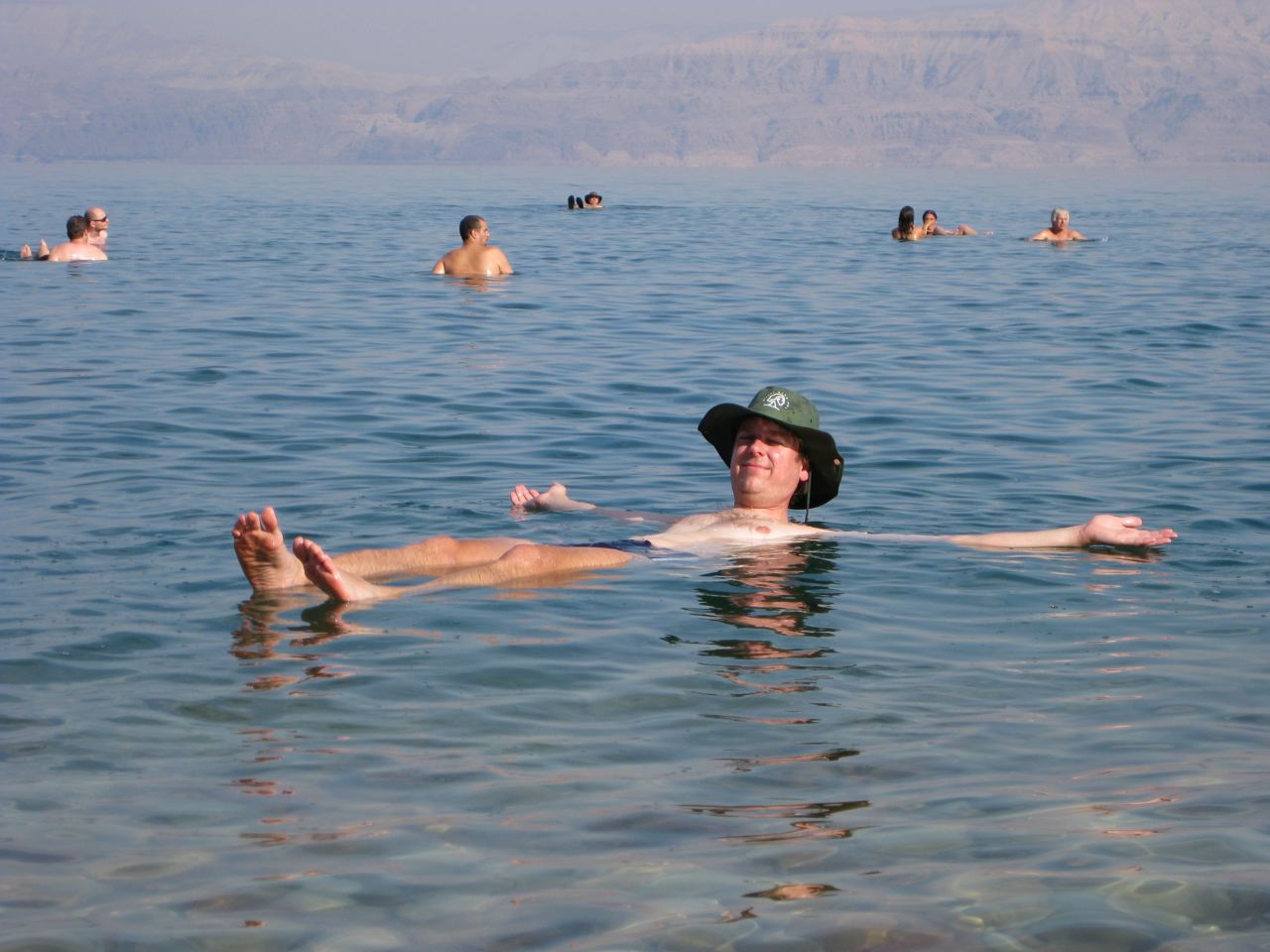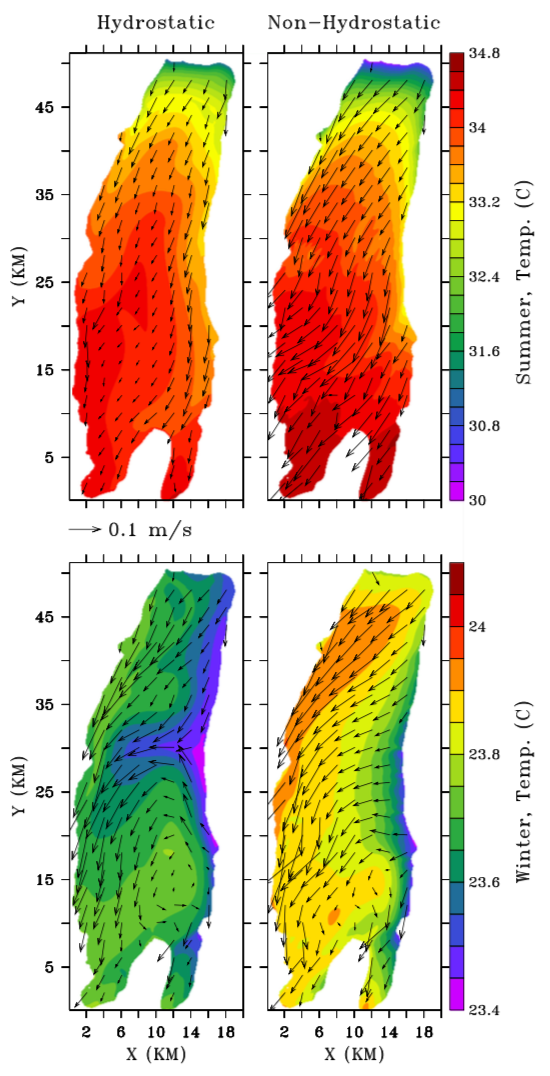
story by Helen Hill for MITGCM

Work from Ben Gurion University in Israel uses MITgcm to explore the importance of non-hydrostatic effects in the Dead Sea.
Yossi (Yosef) Ashkenazy (who proudly tells me he has been using MITgcm for sixteen years now!) is a professor in the Department of Solar Energy and Environmental Physics at Ben Gurion University of the Negev. He is interested in climate dynamics and modeling, especially paleoclimate and statistical analysis of climate records, and sand dune dynamics and modeling.
The Dead Sea is the saltiest and lowest terminal lake in the world. Currently, the water level in the Dead Sea is dropping by more than 1 m per year, the result of excessive use of the water that previously flowed into it. Winter deep convection in the Dead Sea together with its deep and narrow topography suggest that non-hydrostatic effects may be important in determining circulation in the basin however, until now, the impact of non-hydrostatic effects have not been systematically investigated.
In a new study co-authored with graduate student Oded Padon, Ashkenazy performed high resolution (100 m) simulations of the Dead Sea using MITgcm which show that the non-hydrostatic results are very different from the hydrostatic ones. Specifically, the pair report that they found their winter non-hydrostatic simulations resulted in a surface layer of dense water overlaying slightly lighter water during the several last hours of the night implicated in a convection process involved plumes of heavier sinking water and the entrainment of the plumes.
Padon and Ashkenazy also studied the effect of the wind stress’s diurnal variability and found that too to be important, especially during summer when wind variability was noted to drastically increased the surface kinetic energy although this process did not impact the depth density profile.
The researchers hope their results will be useful for the Dead Sea’s potash industry as well as for assessing the impact the planned Red Sea-Dead Sea canal (that aims to stop and, possibly, to increase the level of the Dead Sea using the Red Sea’s water) can be expected to have on the Dead Sea’s circulation.
To find out more about this work contact Yosef
This Month’s Featured Publication
- Oded Padon and Yosef Ashkenazy (2018), Non-hydrostatic effects in the Dead Sea, Journal of Marine Systems, doi: 10.1016/j.jmarsys.2018.06.007
Previous MITgcm reporting involving Yosef Ashkenazy
Snowballs in Summer the MITgcm blog
Other New Publications
The MITgcm blog took a vacation through July. Included below are the publications we came across that appeared over the past couple of months.
June 2018
Jörn Callies, Raffaele Ferrari (2018), Note on the Rate of Restratification in the Baroclinic Spindown of Fronts, Journal of Physical Oceanography, doi: 10.1175/JPO-D-17-0175.1
Xiao Chen, Bo Qiu, Shuiming Chen, Xuhua Cheng, Yiquan Qi (2018), Interannual Modulations of the 50‐Day Oscillations in the Celebes Sea: Dynamics and Impact, Oceans, doi: 10.1029/2018JC013960
Kenneth G. Hughes, Jody M. Klymak, William J. Williams, Humfrey Melling (2018), Tidally modulated internal hydraulic flow and energetics in the central Canadian Arctic Archipelago, Journal of Geophysical research Oceans, doi: 10.1029/2018JC013770
Samar Khatiwala, Heather Graven, Sarah Payne, Patrick Heimbach (2018), Changes to the Air‐Sea Flux and Distribution of Radiocarbon in the Ocean Over the 21st Century, Geophysical Research Letters, doi: 10.1029/2018GL078172
Jody M. Klymak (2018), Non-propagating Form Drag and Turbulence Due to Stratified Flow over Large-scale Abyssal Hill Topography, Journal of Physical Oceanography, doi: 10.1175/JPO-D-17-0225.1
Komacek, Thaddeus David (2018), The Atmospheric Circulation and Evolution of Close-in Extrasolar Gas Giant Planets, Doctoral thesis, University of Arizona
Lei Li, Fa-Ming Li, Zhao-Wei Wang, Mei-XunZhao, JingZhang, Jing-Ling Ren (2018), Factors influencing the use of dissolved aluminum as a source tracer in the East China Sea and adjacent waters, Marine Chemistry, doi: 10.1016/j.marchem.2018.05.009
Sergio G. Longhitano (2018), Between Scylla and Charybdis (part 1): the sedimentary dynamics of the modern Messina Strait (central Mediterranean) as analogue to interpret the past, Earth-Science Reviews, doi: 10.1016/j.earscirev.2018.06.008
Arnaud Pourchez (2018), Impact de la diapause sur la dynamique de communautés planctoniques dans un écosystème Arctique numérique, Masters thesis, Université Laval, Québec, Canada
Nicole-Jeanne Schlegel, Helene Seroussi, Michael P. Schodlok, Eric Y. Larour, Carmen Boening, Daniel Limonadi, Michael M. Watkins, Mathieu Morlighem and Michiel R. van den Broeke (2018), Exploration of Antarctic Ice Sheet 100-year contribution to sea level rise and associated model uncertainties using the ISSM framework, The Cryosphere Discuss., doi: 10.5194/tc-2018-105
Steffen Tietsche, Magdalena Alonso-Balmaseda, Patricia Rosnay, Hao Zuo, Xiangshan Tian-Kunze, and Lars Kaleschke (2018), Thin Arctic sea ice in L-band observations and an ocean reanalysis, The Cryosphere, doi: 10.5194/tc-12-2051-2018
Tianyu Wang, Sarah T. Gille, Matthew R. Mazloff, Nathalie V. Zilberman, Yan Du (2018), Numerical Simulations to Project Argo Float Positions in the Mid-depth and Deep Southwest Pacific, Journal of Atmospheric and Oceanic Technology, doi: 10.1175/JTECH-D-17-0214.1
Ying Zhang, Ming Feng, Yan Du, Helen E. Phillips, Nathaniel L. Bindoff, Michael J. McPhaden (2018), Strengthened Indonesian Throughflow Drives Decadal Warming in the Southern Indian Ocean, Geophysical Research Letters, doi: 10.1029/2018GL078265
July 2018
Daniel E. Amrhein, Carl Wunsch, Olivier Marchal, Gael Forget (2018), A global glacial ocean state estimate constrained by upper-ocean temperature proxies, Journal of Climate, doi: 10.1175/JCLI-D-17-0769.1
Genevieve Brett (2018), Chaotic advection, mixing, and property exchange in three-dimensional ocean eddies and gyres, PhD dissertation, MIT-WHOI Joint Program, https://darchive.mblwhoilibrary.org/bitstream/handle/1912/10413/Brett_thesis.pdf
Henrique Coelho, Zhong Peng, Dave Sproson, Jill Bradon (2018), A Methodology to Characterize Internal Solitons in the Ocean, Proceedings of the 37th International Conference on Ocean, Offshore & Artic Engineering, ICONE14, June 17-22, 2018, Madrid, Spain
Edward A. Doddridge and Alexey Radul (2018), Aronnax: An idealised isopycnal ocean model, the Jounral of Open Source Software, doi: 10.21105/joss.00592
M. J. Fried, G. A. Catania, L. A. Stearns, D. A. Sutherland, T. C. Bartholomaus, E. Shroyer, J. Nash (2018), Reconciling Drivers of Seasonal Terminus Advance and Retreat at 13 Central West Greenland Tidewater Glaciers, Journal of Geophysical Research – Earth Surface, doi: 10.1029/2018JF004628
Xiaolin Jin, Young-Oh Kwon, Caroline C. Ummenhofer, Hyodae Seo, Yu Kosaka, and Jonathon S. Wright (2018), Distinct mechanisms of decadal subsurface heat content variations in the eastern and western Indian Ocean modulated by tropical Pacific SST, Journal of Climate, doi: 10.1175/JCLI-D-18-0184.1
Kerstin Kretschmer, Lukas Jonkers, Michal Kucera, and Michael Schulz (2018), Modeling seasonal and vertical habitats of planktonic foraminifera on a global scale, Biogeosciences, 15, 4405–4429, doi: 10.5194/bg-15-4405-2018
Bernawis Lamona, Judith Hauck and Christoph Völke (2018), Evaluation of a global ocean general circulation model; The Lat-Lon-Cap (LLC90) configuration of the MITgcm, IOP Conference Series: Earth and Environmental Science, Volume 162, conference 1, doi: 10.1088/1755-1315/162/1/012002
Ayah Lazar, Qiong Zhang and Andrew F. Thompson (2018), Submesoscale Turbulence over a Topographic Slope, Fluids, doi: 10.3390/fluids3020032
E. Panassa, C. Völker, D. Wolf‐Gladrow, J. Hauck (2018), Drivers of Interannual Variability of Summer Mixed Layer Depth in the Southern Ocean Between 2002 and 2011, Journal of Geophysical Research Oceans, doi: 10.1029/2018JC013901
Rocha, Cesar Barbedo (2018), The turbulent and wavy upper ocean: transition from geostrophic flows to internal waves and stimulated generation of near-inertial waves, PhD dissertation, University of California, San Diego, https://search.proquest.com/openview/18478c2f9225d0d5f24adfd29b779675/1
Antonio Sanchez-Roman, Gabriel Jorda, Gianmaria Sannino and Damia Gomis (2018), Modelling study of transformations of the exchange flows along the Strait of Gibralter, Ocean Sci. Discuss., doi: 10.5194/os-2018-57
Adam P. Showman, Xianyu Tan, and Xi Zhang (2018), Atmospheric Circulation of Brown Dwarfs and Jupiter and Saturn-like Planets: Zonal jets, long-term variability, and QBO-type oscillations, arXiv:1807.08433v1[astro-ph.EP]
Nathaniel Tarshish, Ryan Abernathey, Ci Zhang, Carolina O. Dufour, Ivy Frenger, Stephen M.Griffies (2018), Identifying Lagrangian Coherent Vortices in a Mesoscale Ocean Model, Ocean Modelling, doi: 10.1016/j.ocemod.2018.07.001
Shuya Wang, Jinhu Wang, Xu Chen, Jing Meng, Huan Wang (2018), Density Perturbation and Energy Flux of Internal Waves from Velocity Data, Journal of Ocean University of China, doi: 10.1007/s11802-018-3653-0
Michael Wood, Eric Rignot, Ian Fenty, Dimitris Menemenlis, Romain Millan, Mathieu Morlighem, Jeremie Mouginot, Helene Seroussi (2018), Ocean‐induced melt triggers glacier retreat in Northwest Greenland, Geophysical Research Letters, doi: 10.1029/2018GL078024
Zaron, E., and C. Rocha (2018), Meeting Summary: Internal Gravity Waves and Meso/Sub-mesoscale Currents in the Ocean – anticipating high-resolution observations from the Surface Water & Ocean Topography (SWOT) swath altimeter mission, Bull. Amer. Meteor. Soc. doi: 10.1175/BAMS-D-18-01 33.1
Do you have news about research using MITgcm? We are looking for contributions to these pages. If you have an interesting MITgcm project (ocean, atmosphere, sea-ice, physics, biology or otherwise) that you want to tell people about, get in touch. To make a post, contact Helen

